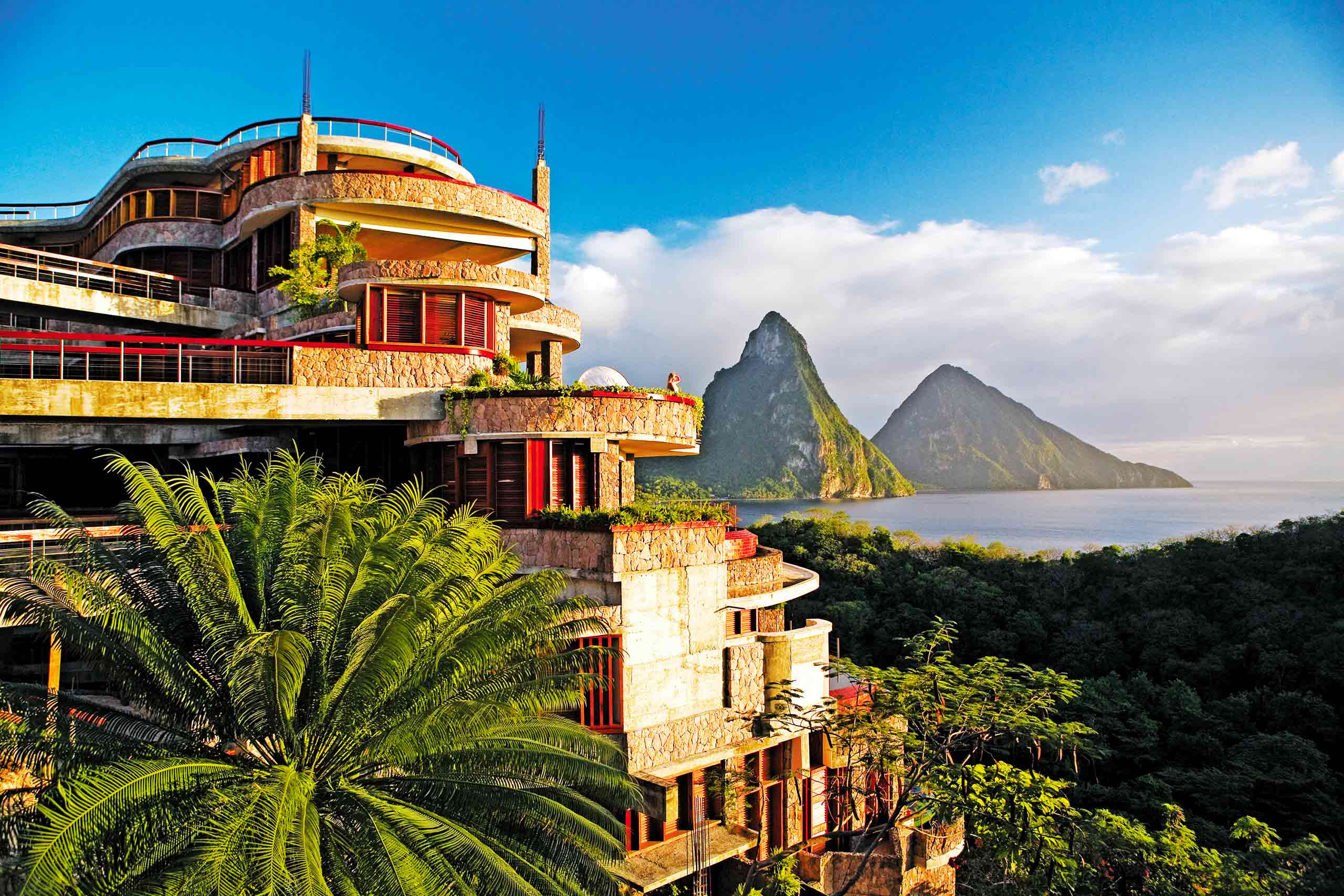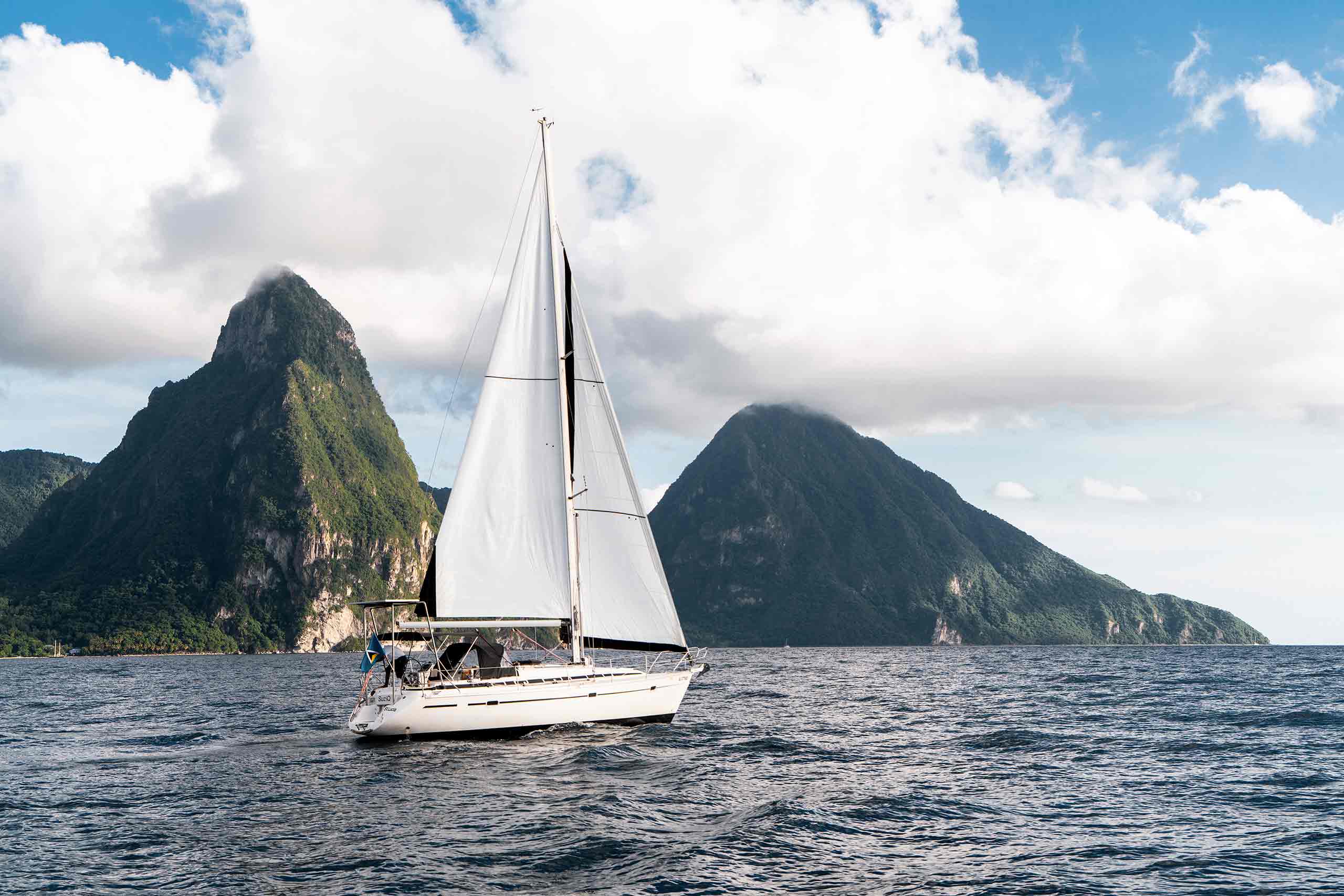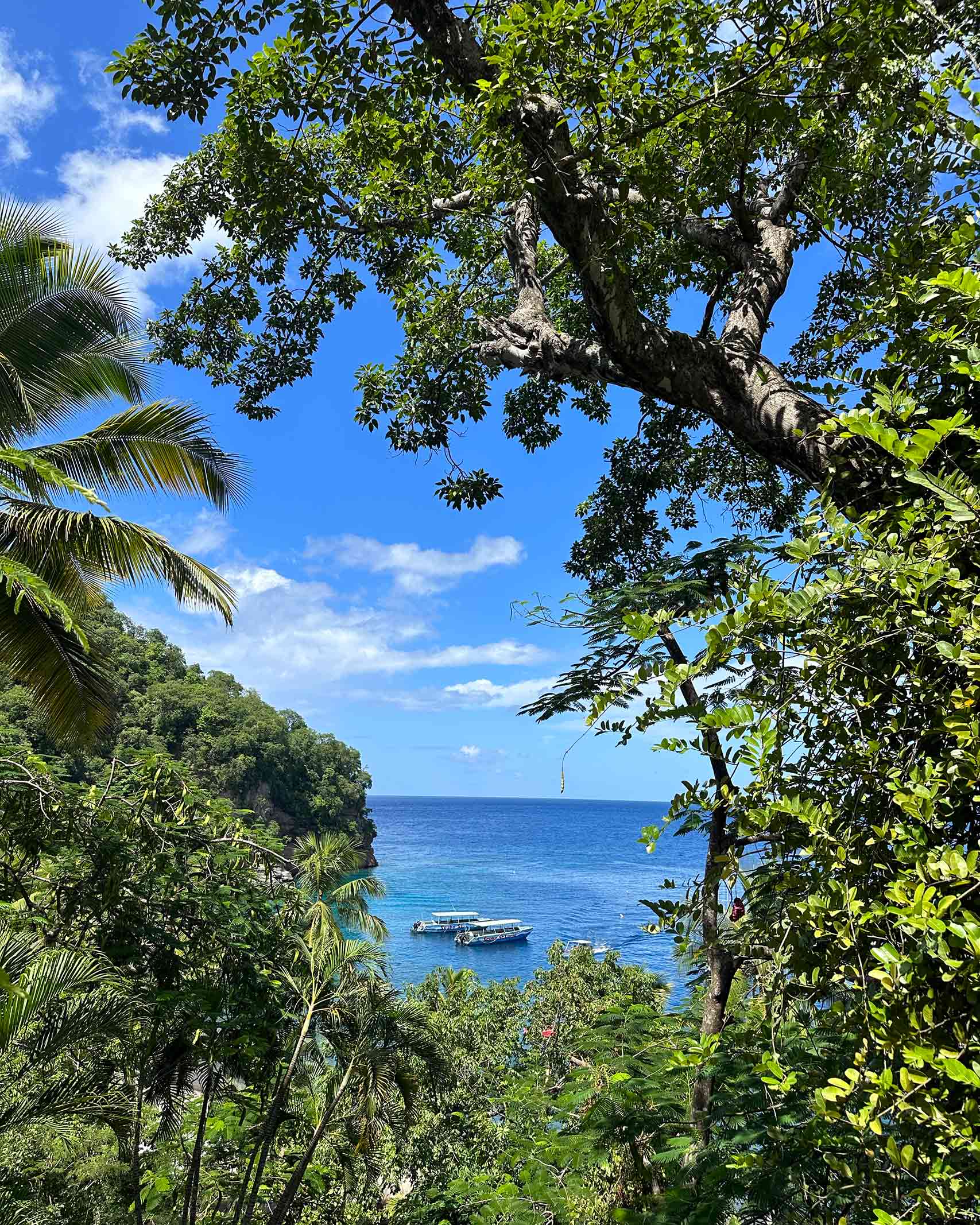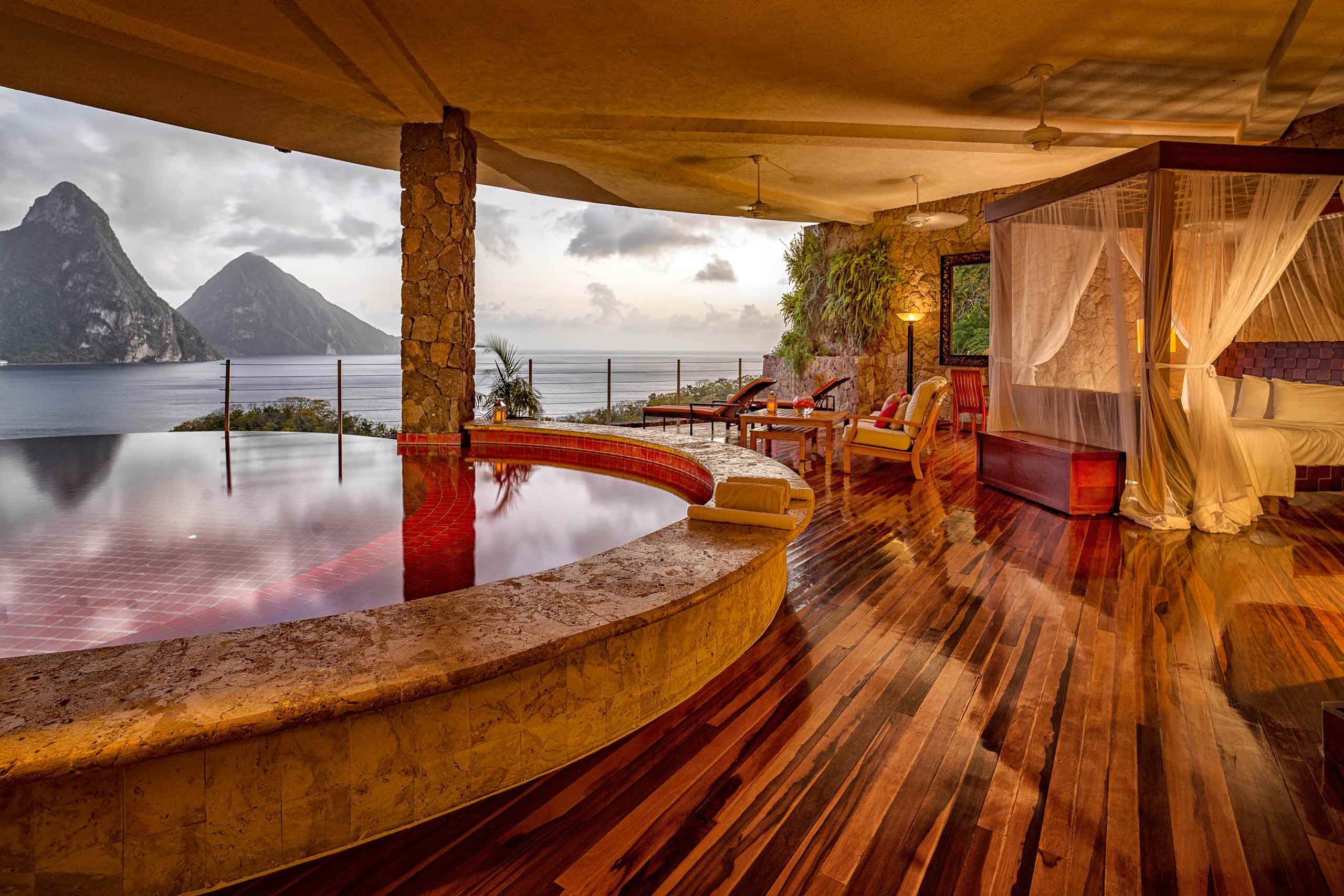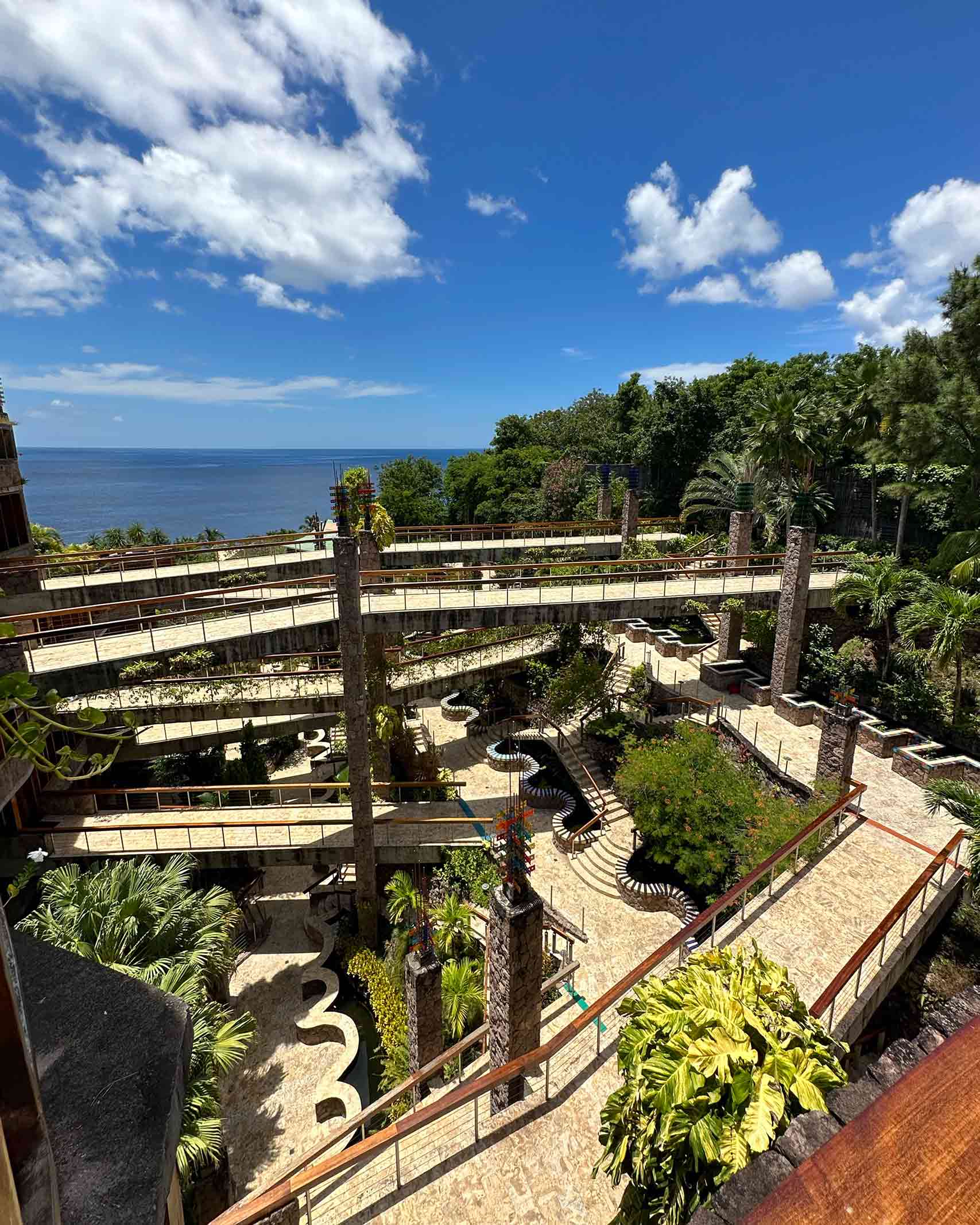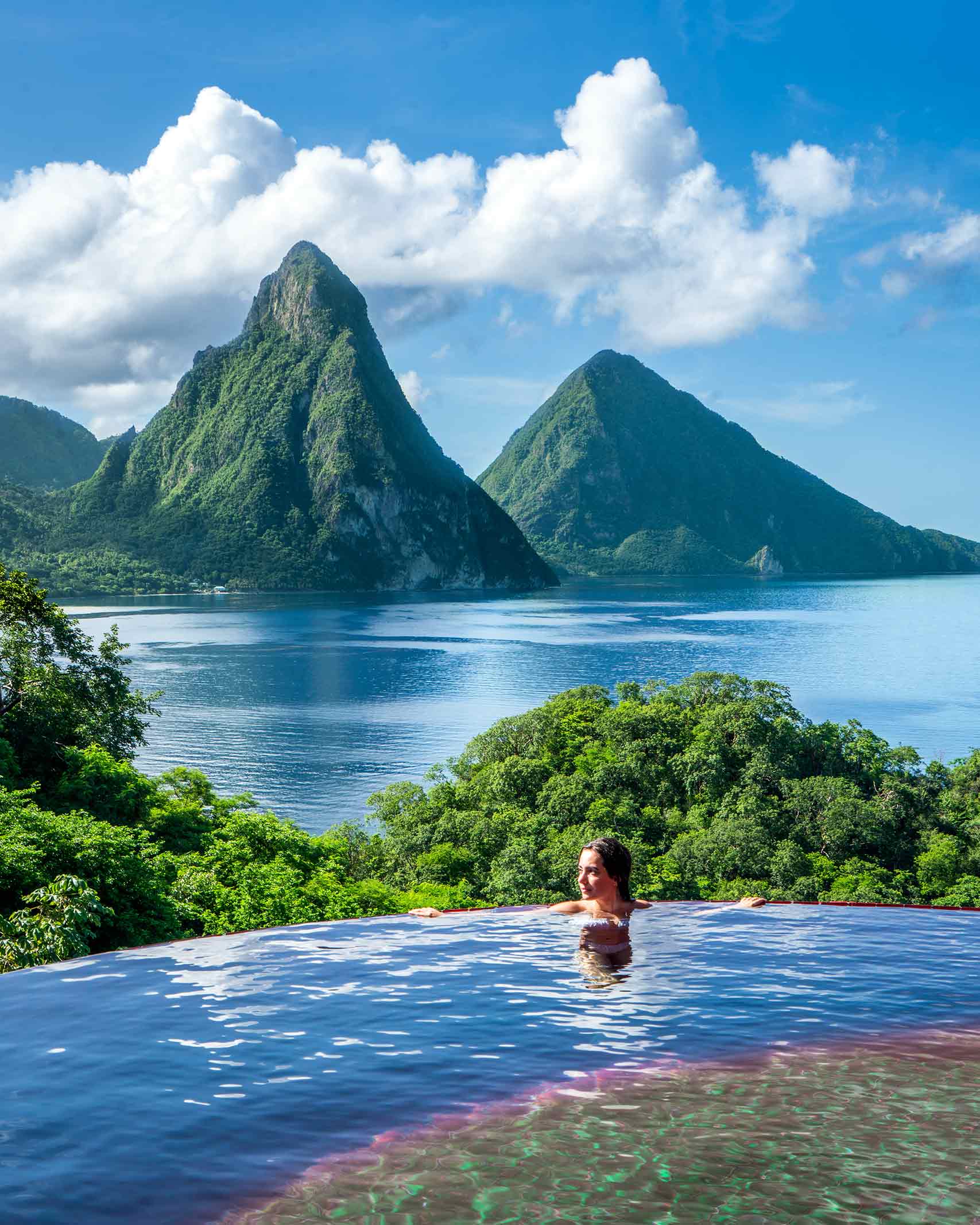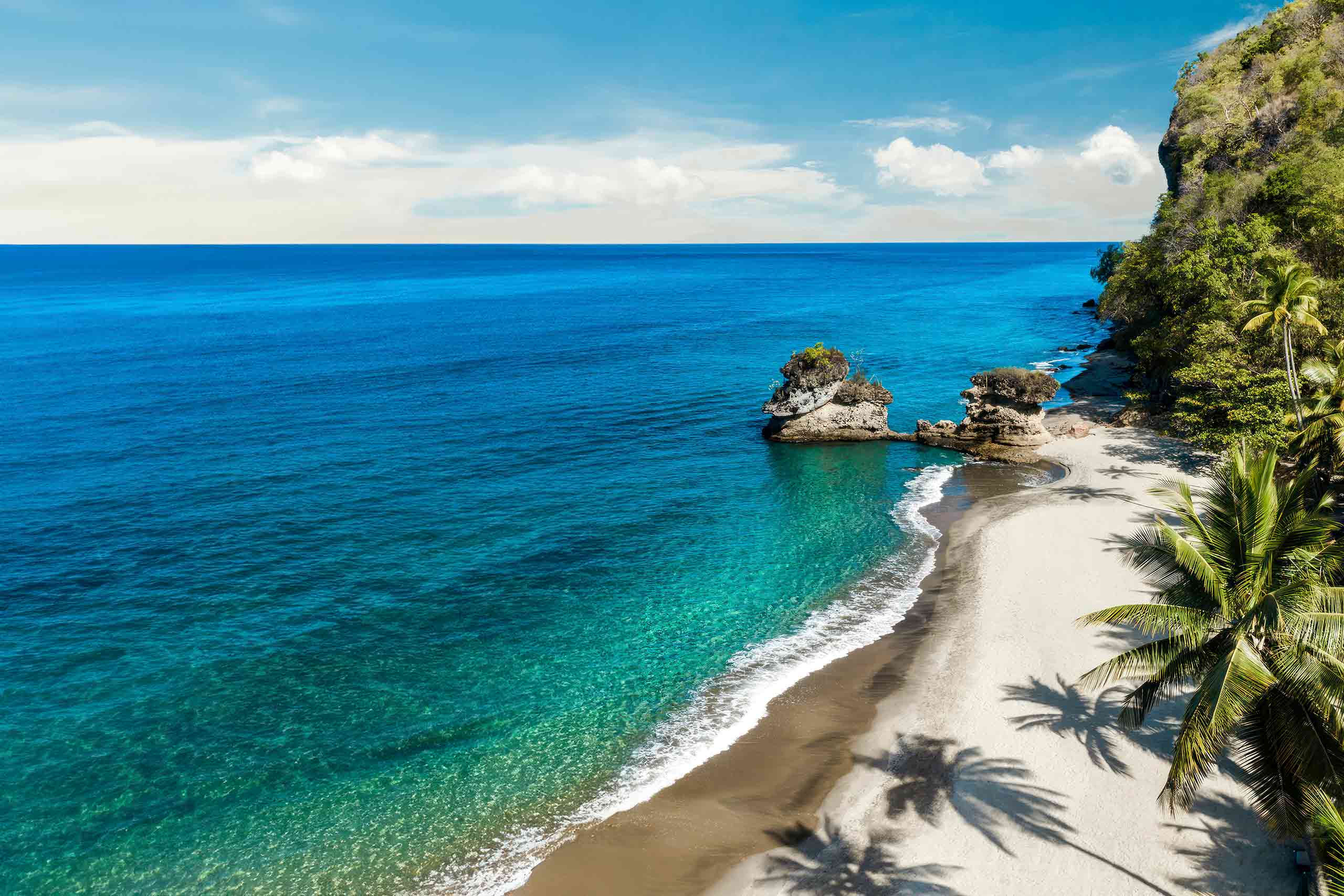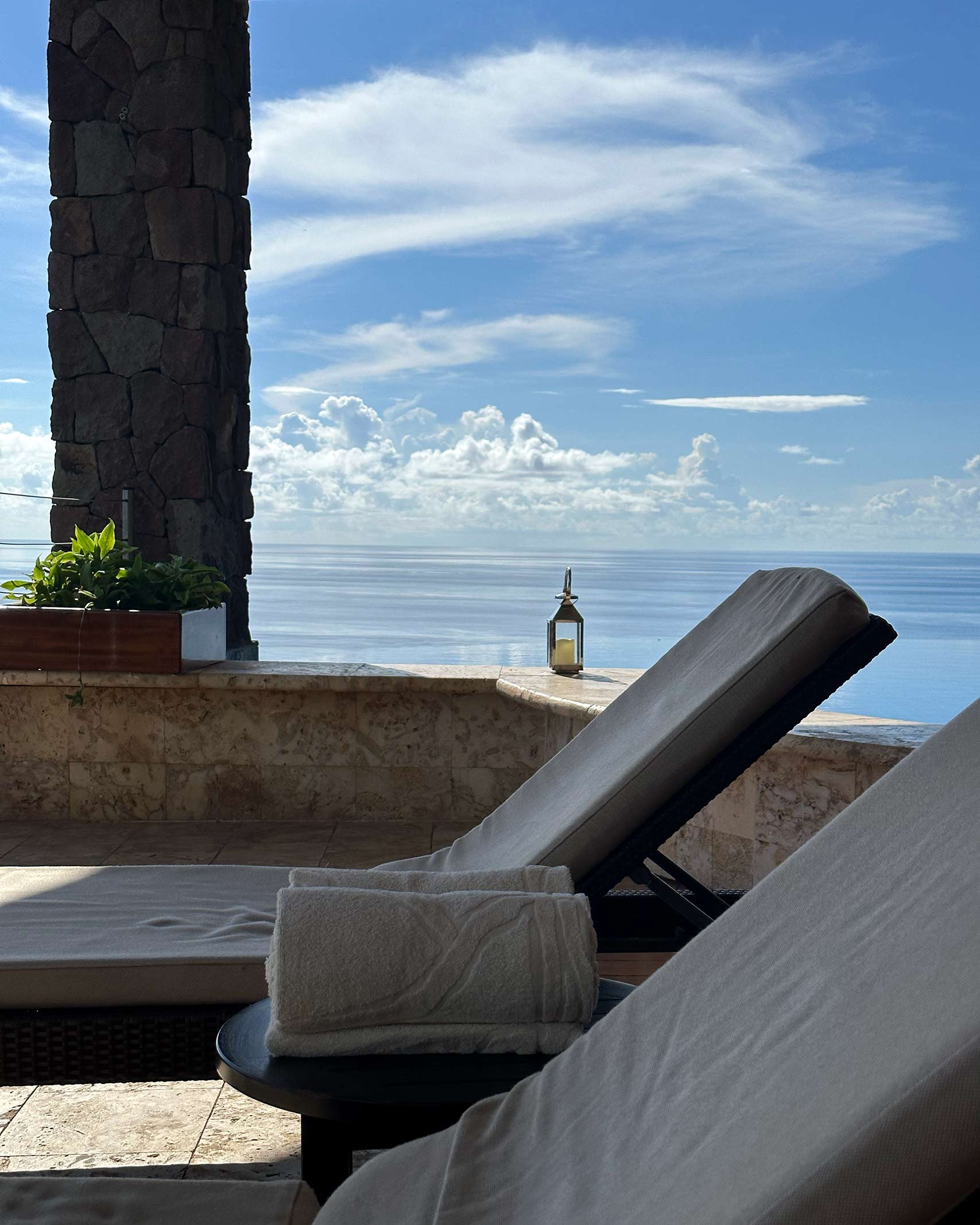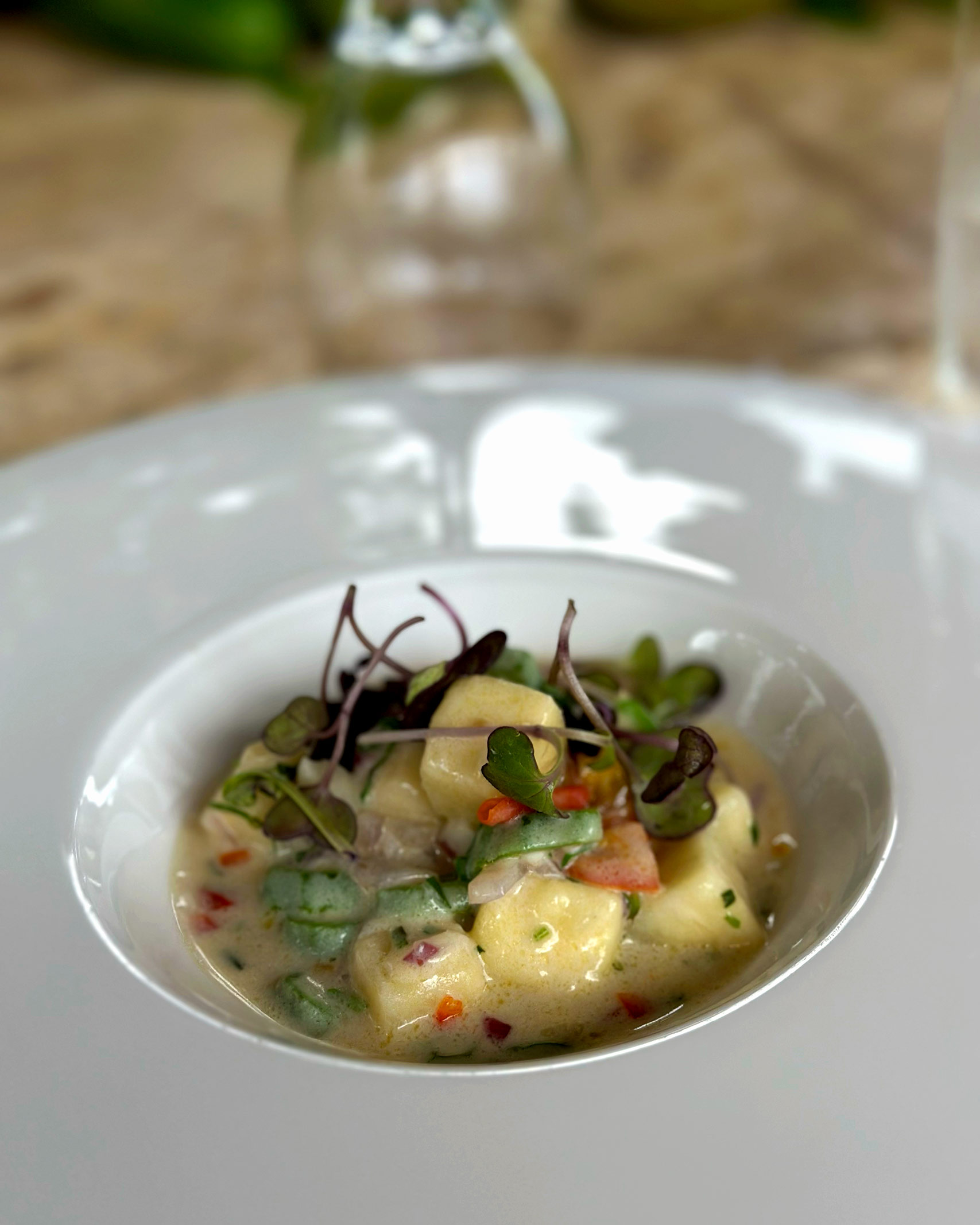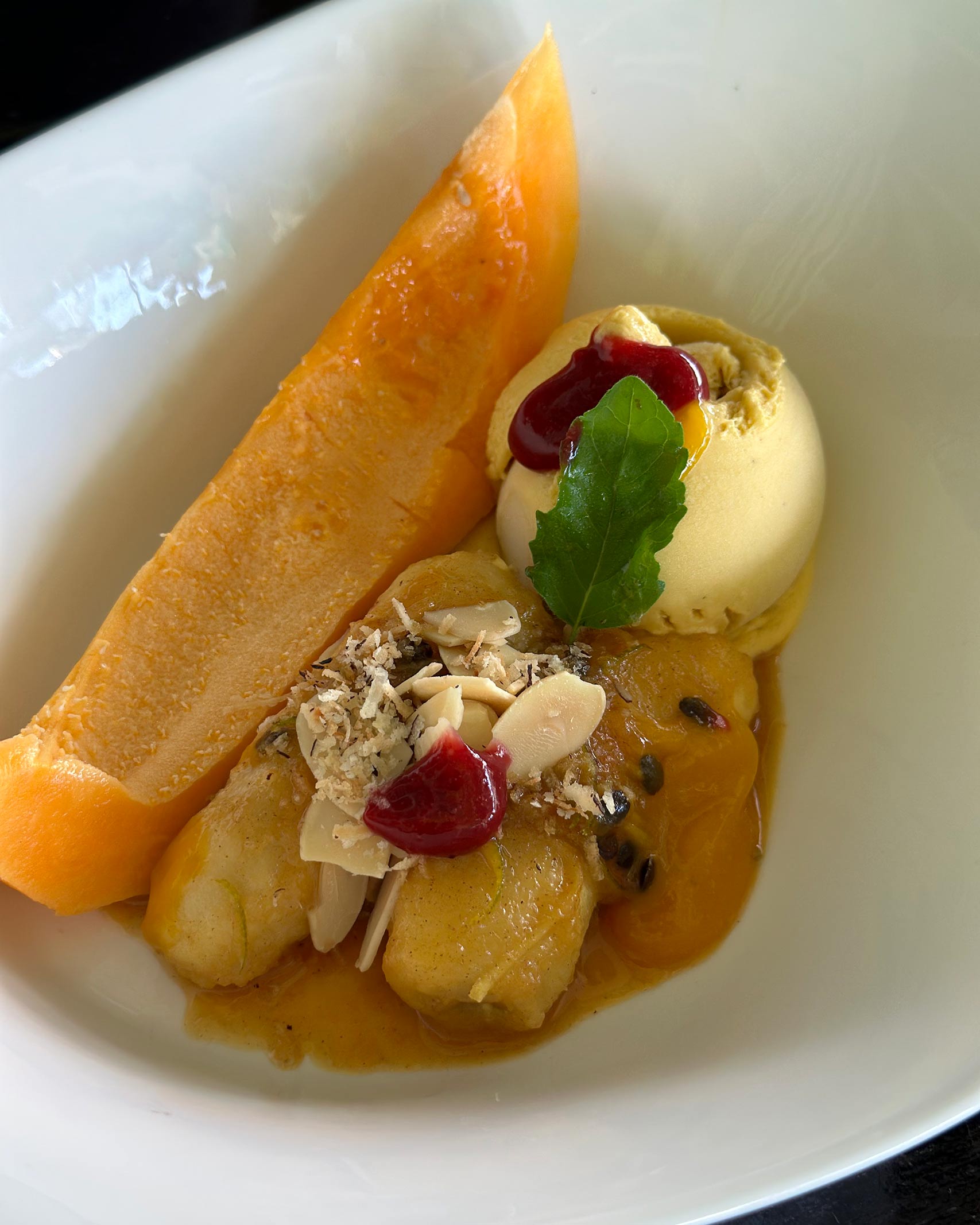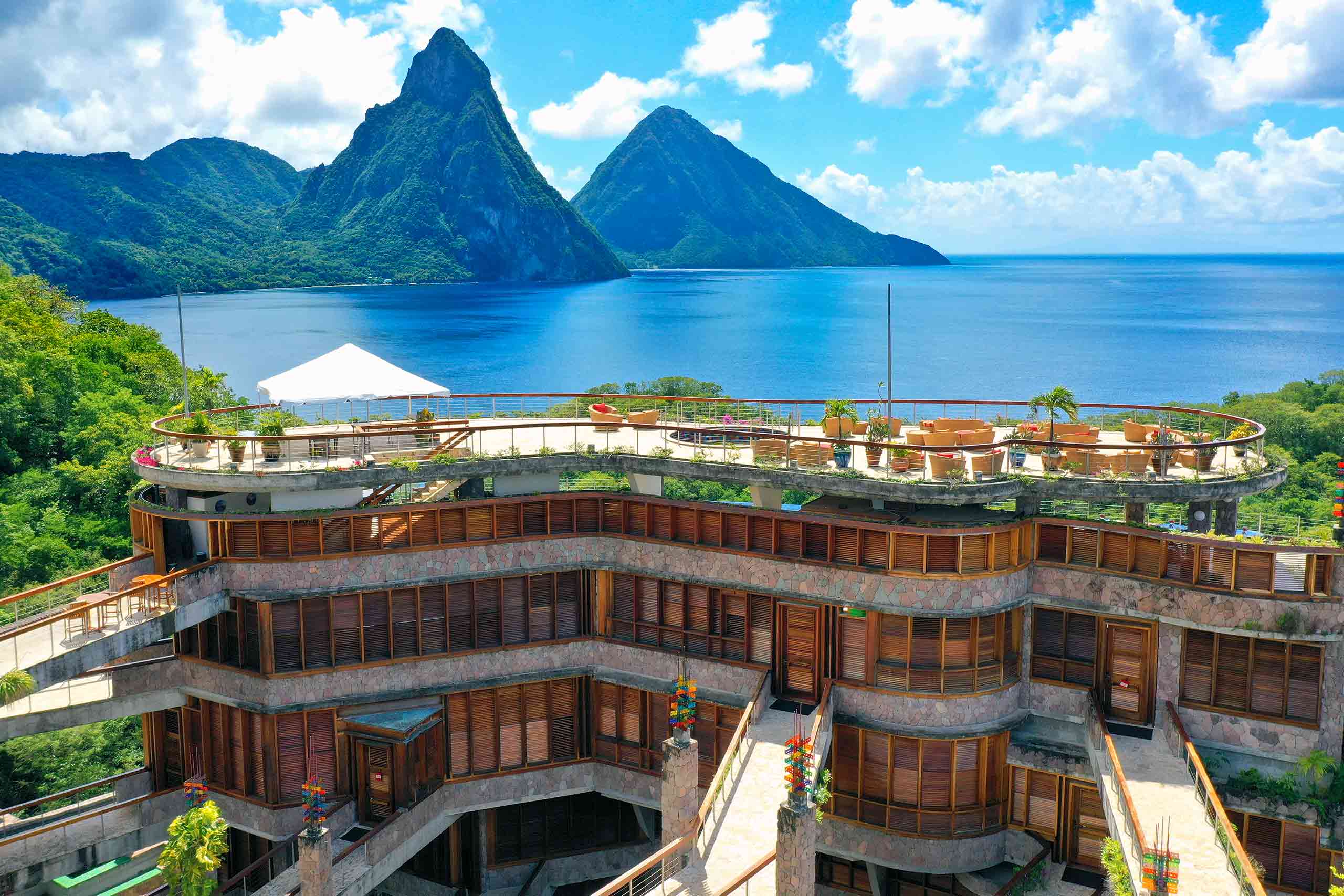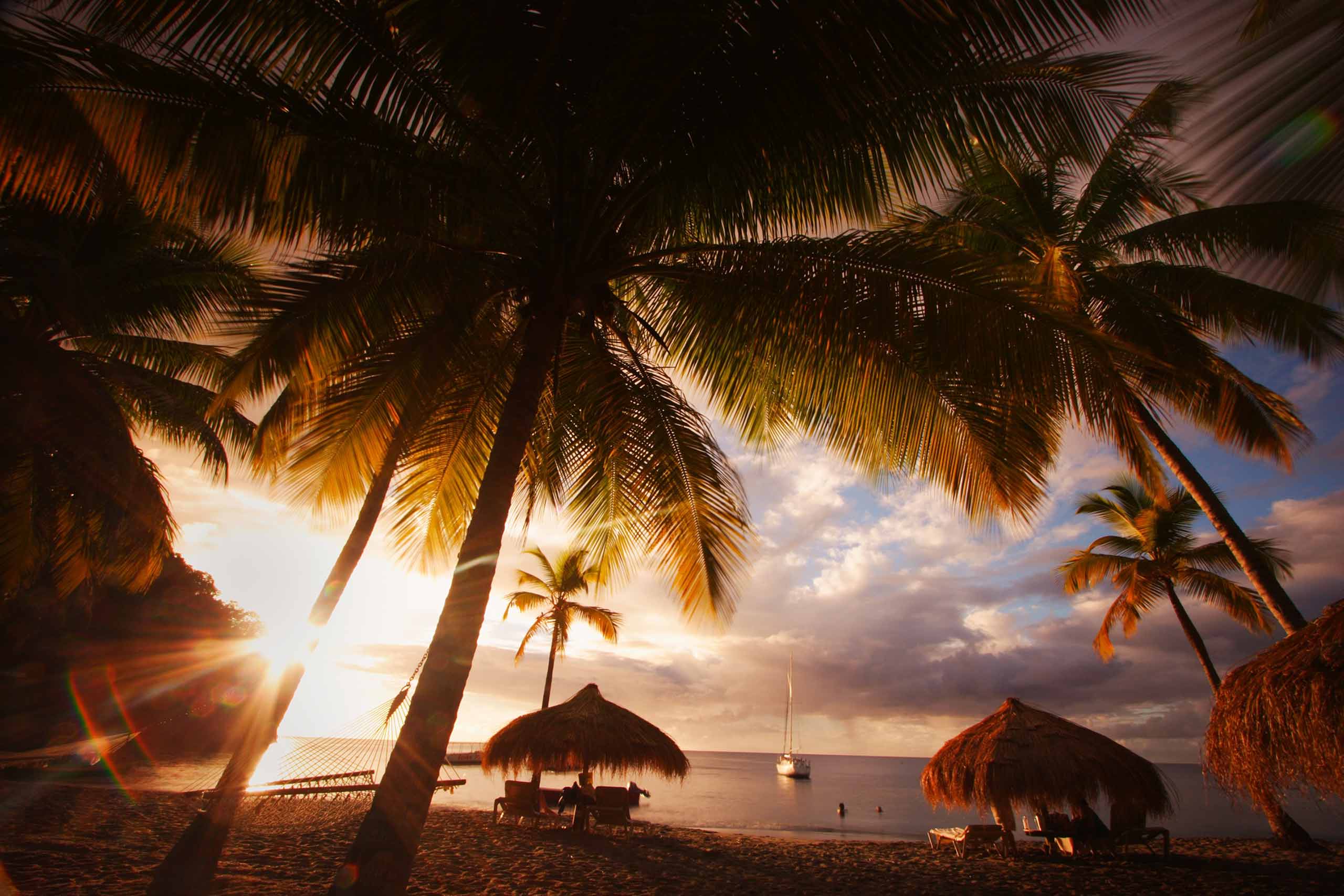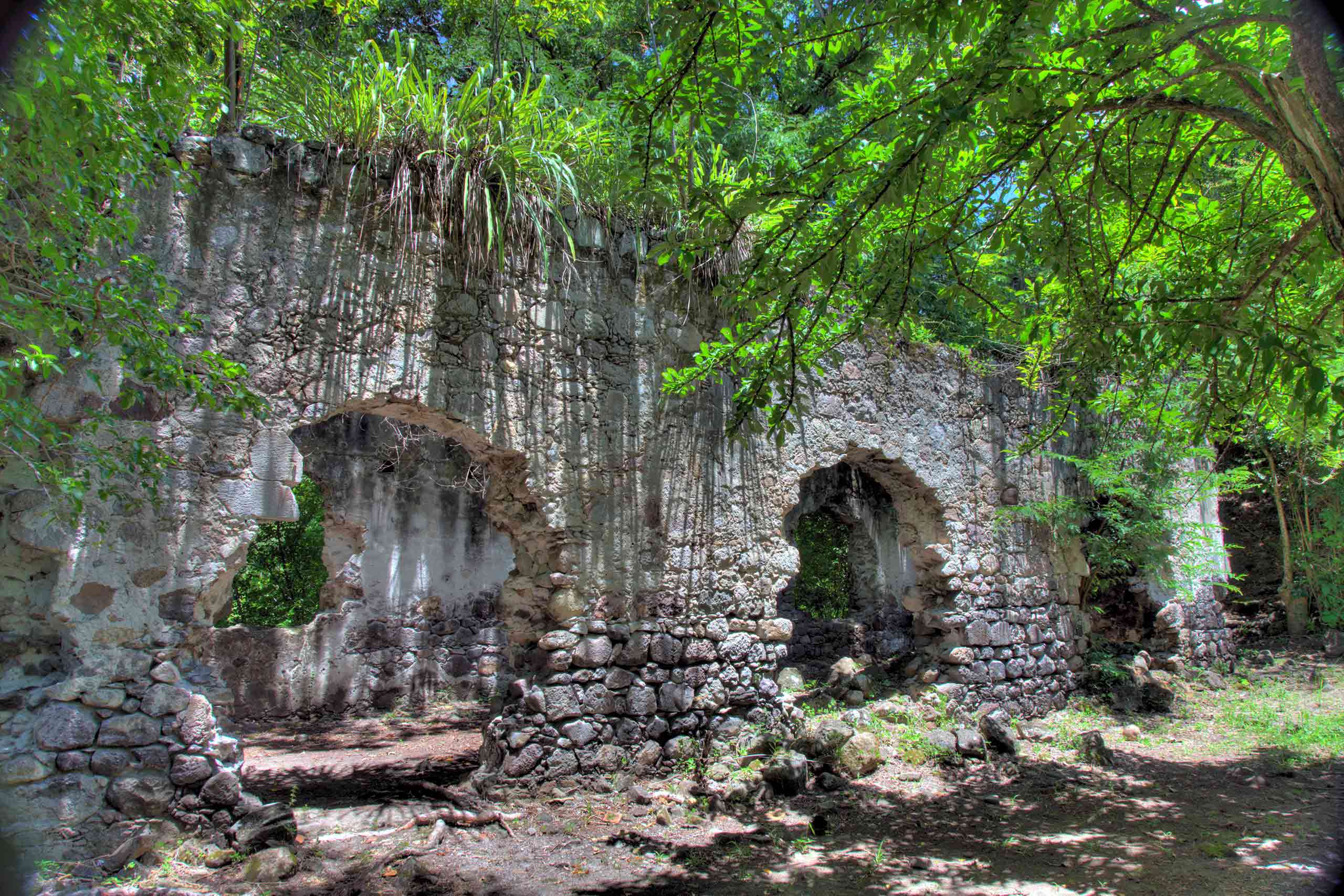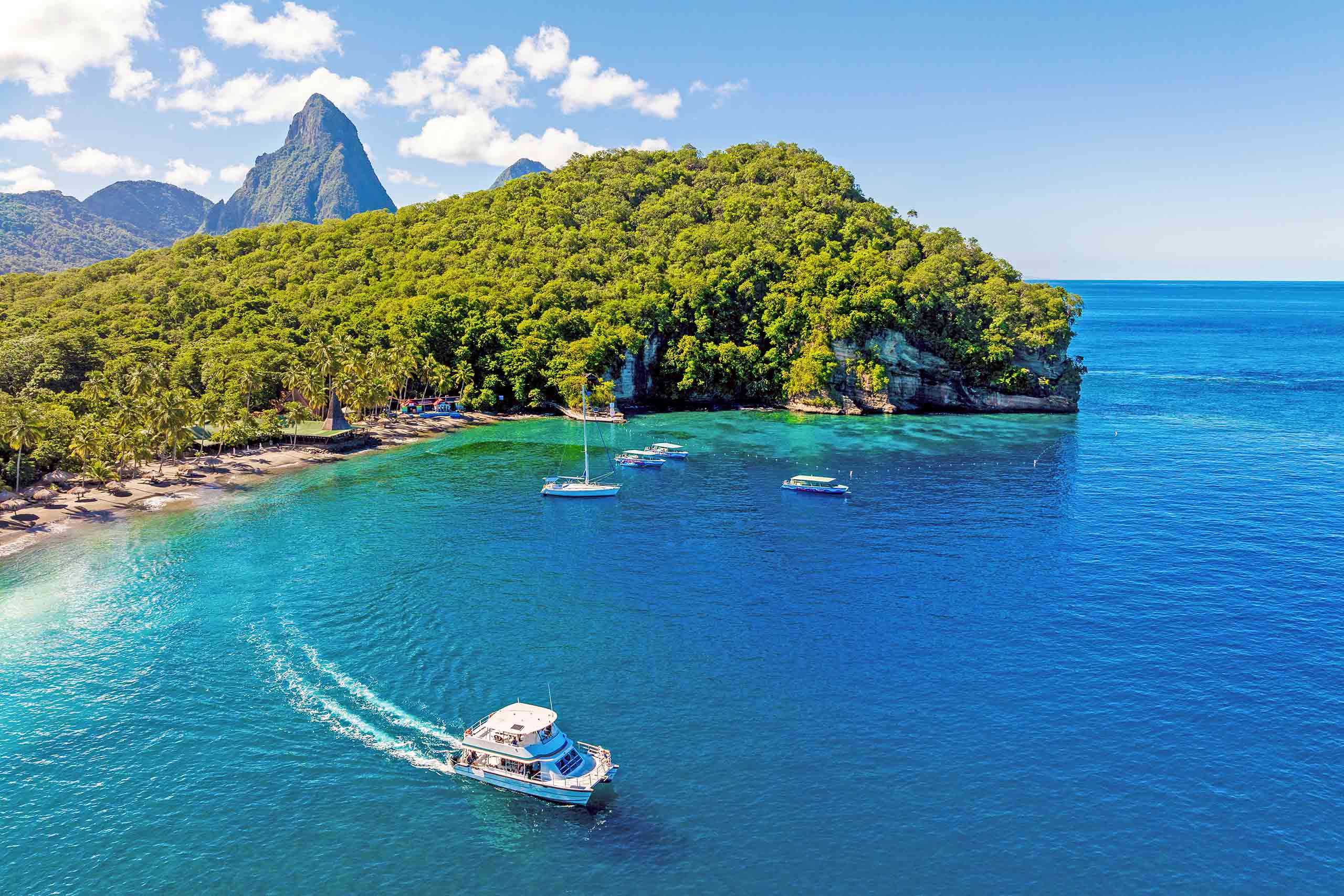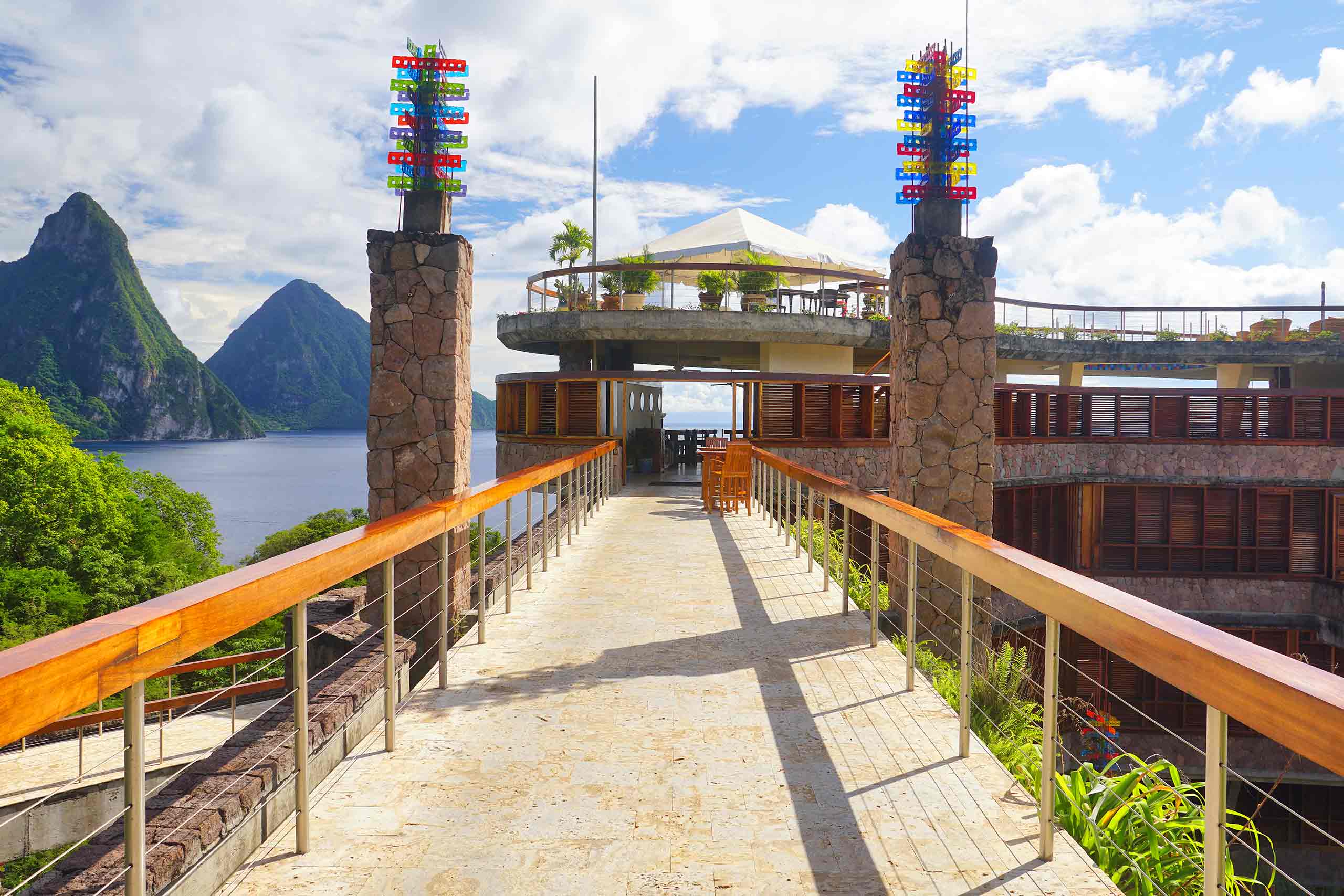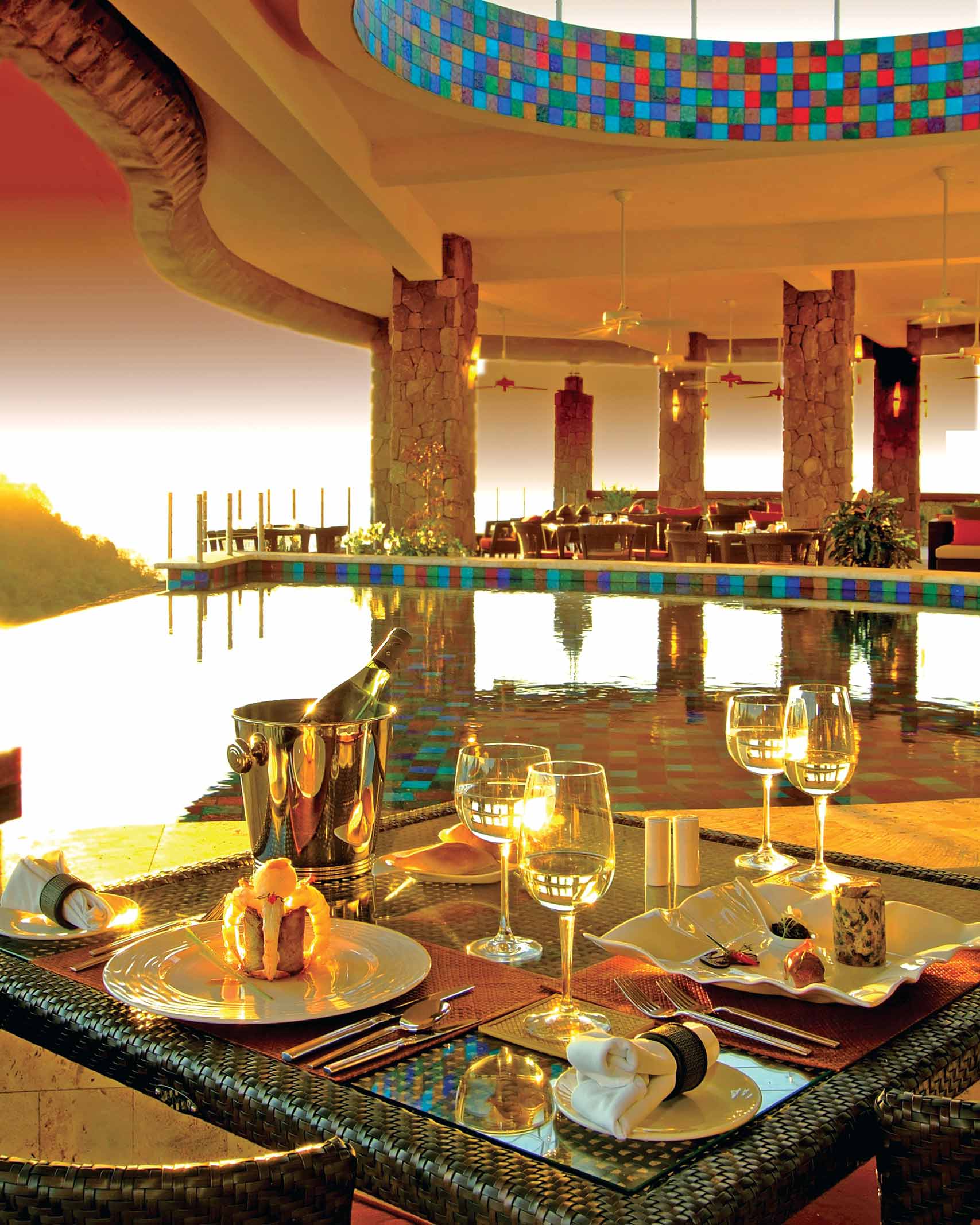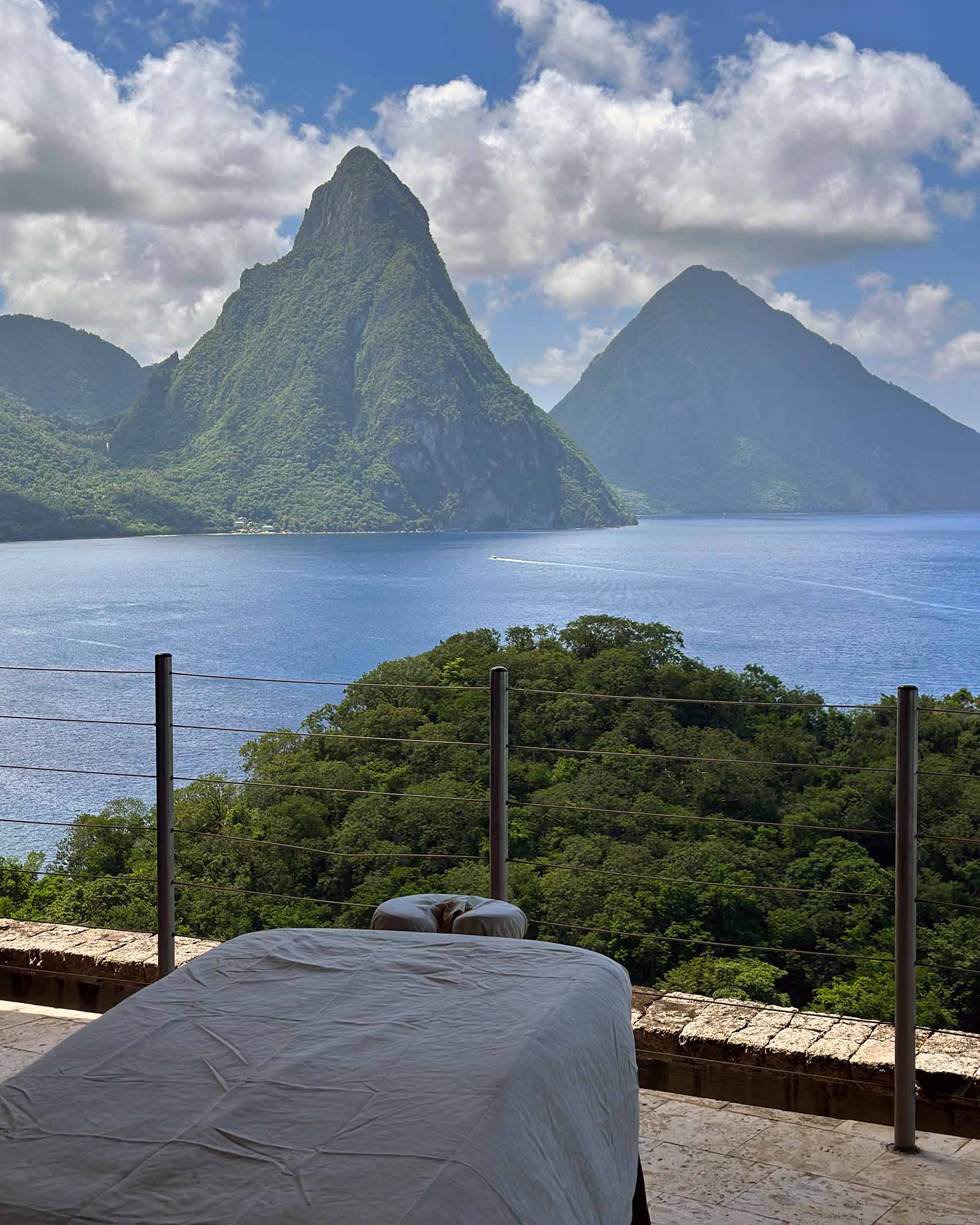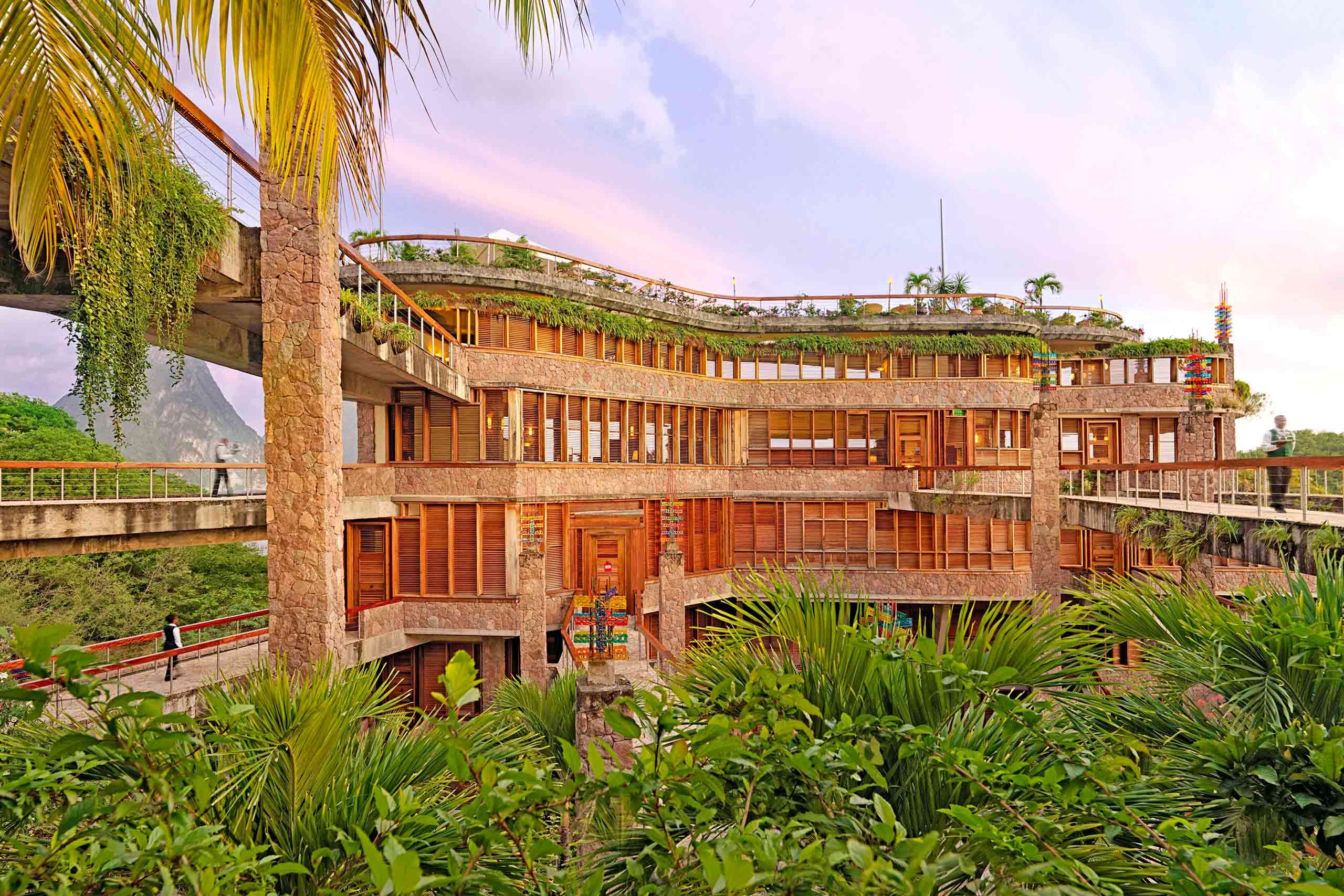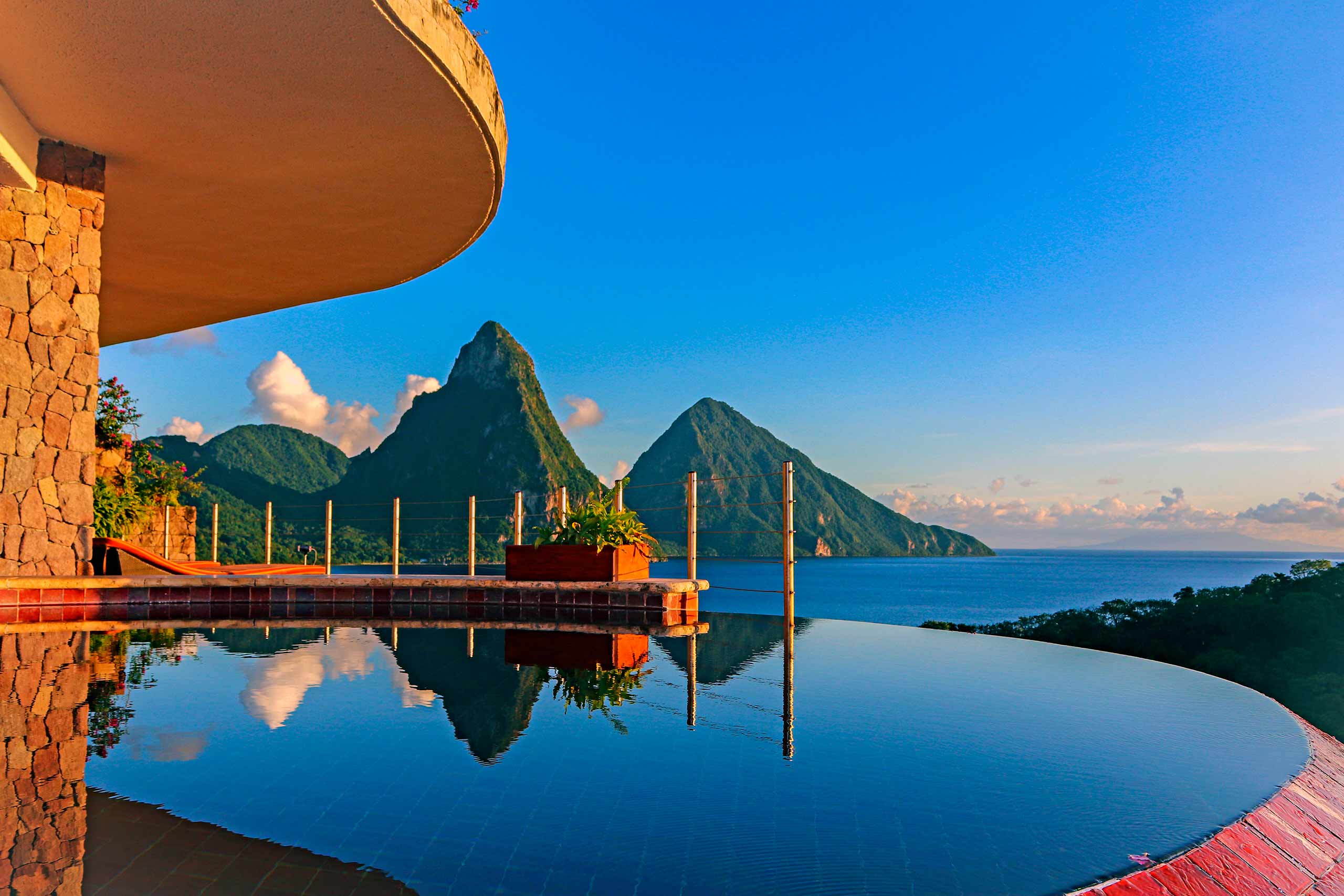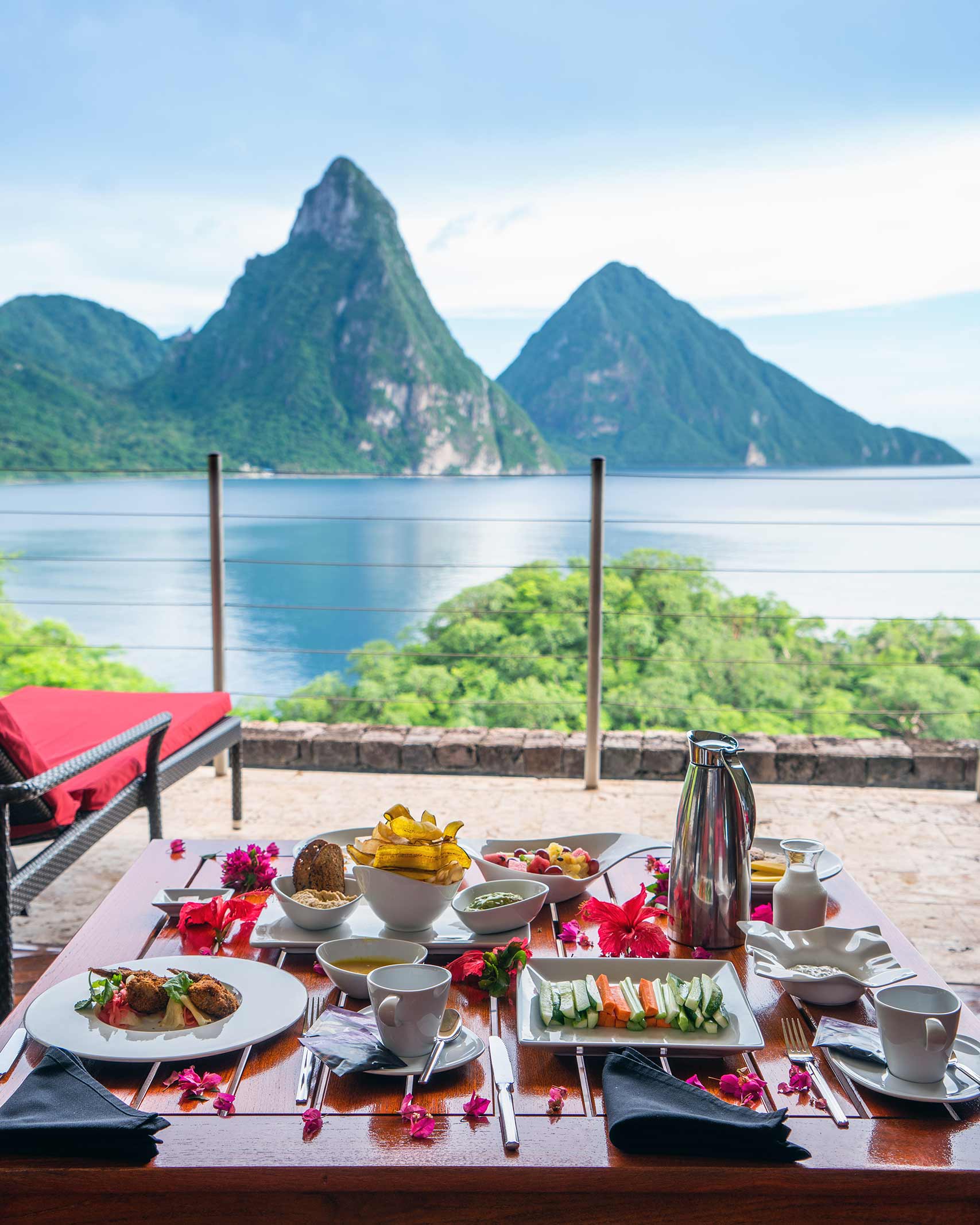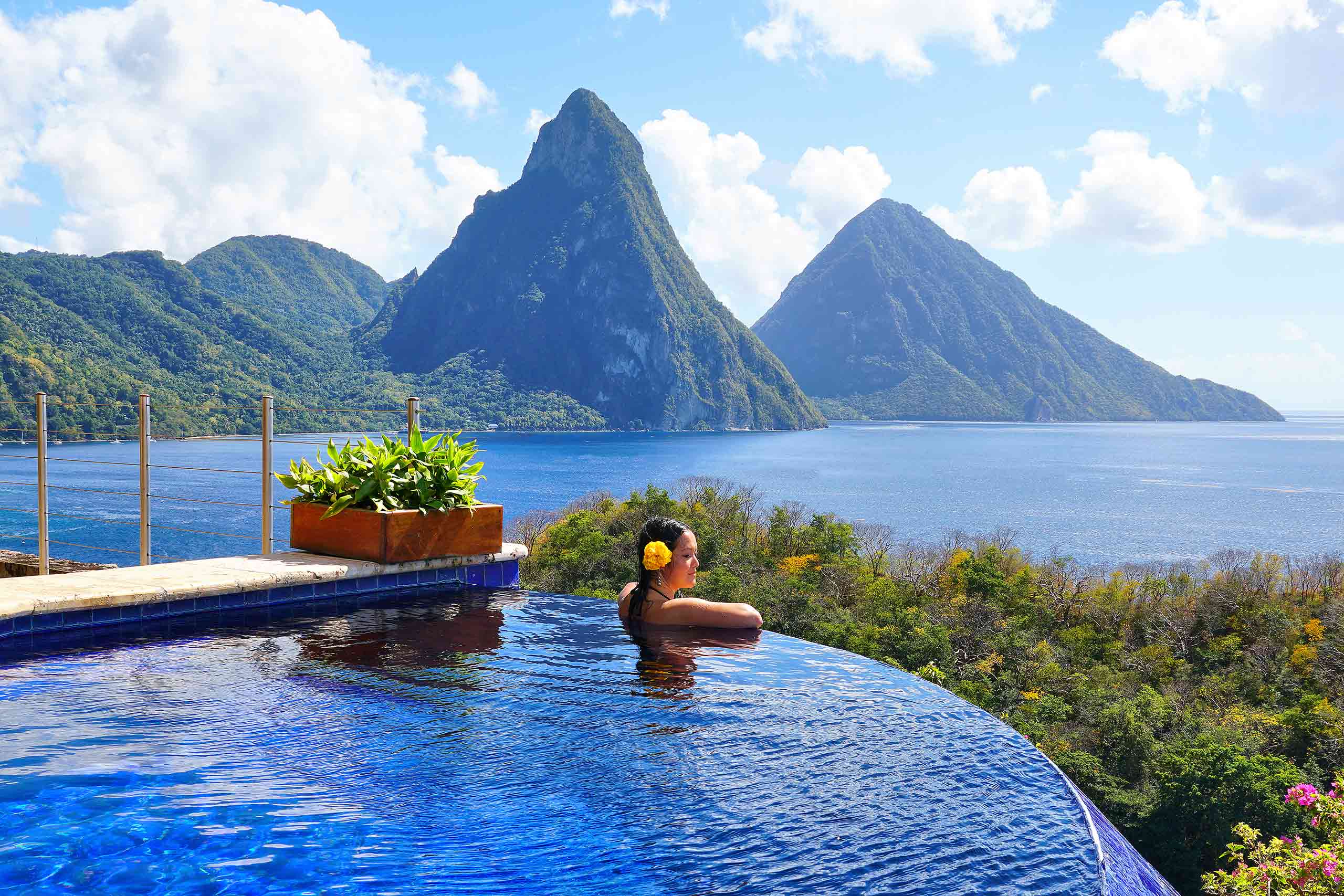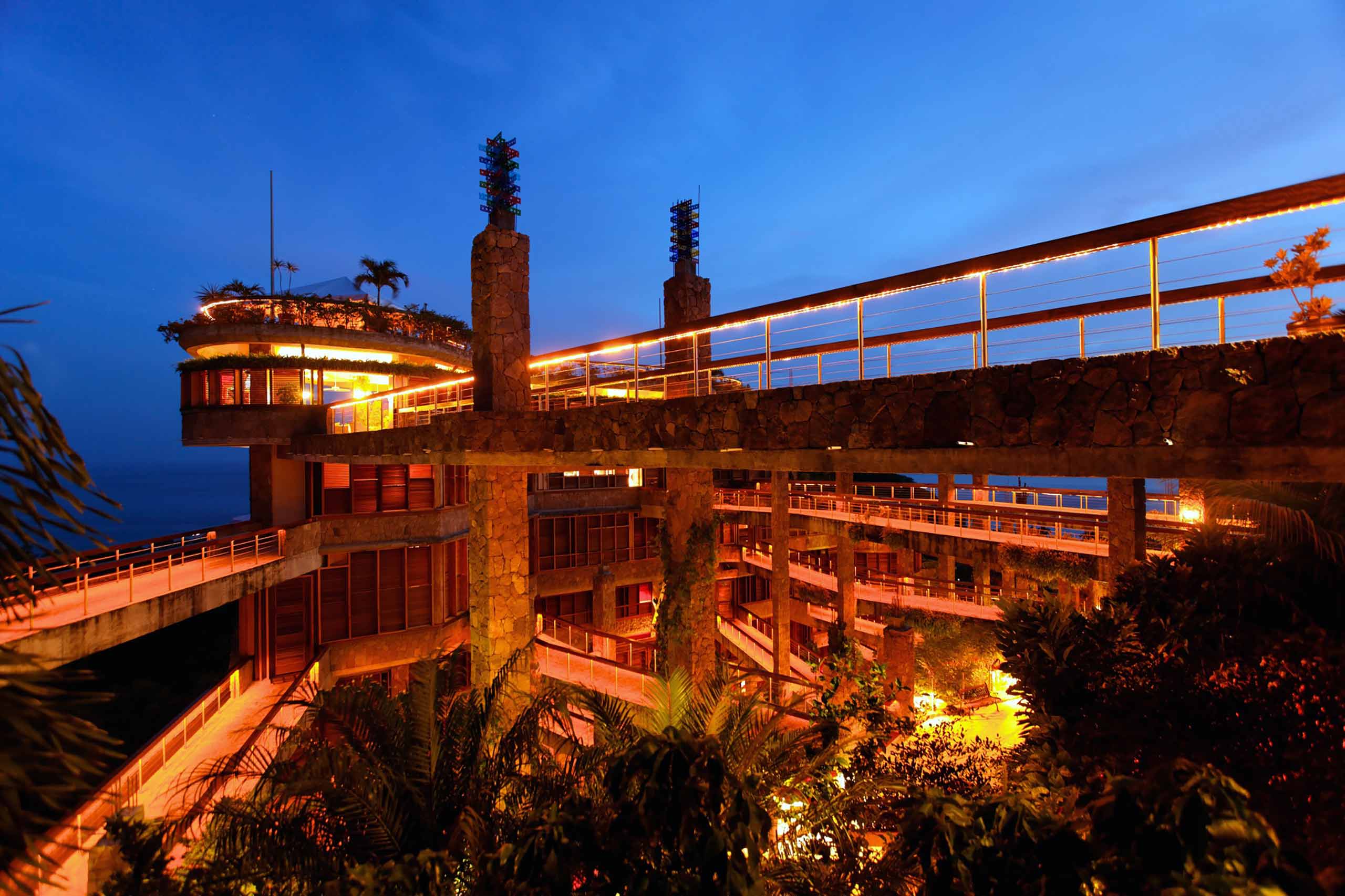At this one-of-a-kind Saint Lucia resort, the night-time soundscape is so exhilarating that some guests try not to fall asleep with an ear pressed into a pillow, instead lying flat, as if in protest at the idea of missing such sublime sonic beauty. Jade Mountain is a place of great spectacle and still greater theatricality.
Falling asleep in a king-size hotel bed on the first night of a vacation, after a gruelling long-haul flight, has to rank among life’s greatest joys – the touch of soft linen on your skin, a sense of having arrived and the familiar sound of an AC working hard to keep you cool. But bedding down in our hotel on Saint Lucia, it’s not white noise we hear, but a symphony of waves, winds, whistling frogs and crickets crawling around the rustling rainforest below.
When we wake, the sound of chirping crickets has been washed over by that of singing swallows. We’re up early, not only because our circadian rhythms have yet to adjust to the local time, but also because the sun rises directly onto our faces. Our Galaxy sanctuary is open on two sides, inviting in the elements while granting us uninterrupted views of a UNESCO World Heritage Site straight ahead. It’s the two Pitons that give Saint Lucia its distinctive appearance and make it perhaps the most dramatic of islands in the Lesser Antilles. There being no walls, nothing stands between us and these shark-tooth-shaped ‘volcanic plugs’. Not an atom of glass or glue, no stainless steel, no wood and no cement – just the thick, honey-flavoured, golden breeze of the Caribbean.

This story first appeared in The Paris is Turning Issue, available in print and digital.
Subscribe today or purchase a back copy via our online shop.
We’re staying at Jade Mountain, a hilltop resort whose creators we’d like to say threw out of the window the rulebook on how to build a hotel, except, of course, there are no windows here. In the realm of architecture, concept sketches are watered down in stages. First, after meeting with the client, then before construction begins, and on occasion before it concludes. But at Jade Mountain, the architect, Russian-Canadian Nick Troubetzkoy, was the client, which helps explain why the resort looks like something you rub your eyes at in disbelief: a concept sketch come to life.
Nick arrived on Saint Lucia in 1970, buying the Anse Chastanet hotel, which sits at the foot of Jade Mountain, fronted by two palm-tree-flanked beaches. There were only eight small octagonal buildings then, set within a tropical jungle habitat. His vision was to grow the property (today it comprises 49 private lodgings) and introduce the concept of sea-view rooms, then a novelty in the Caribbean. The idea was that guests wouldn’t have to leave their accommodation to feel connected to the abundant natural beauty all around, and it culminated in the more recently built resort Jade Mountain, which opened its doors in 2006 and has since become one of the world’s most recognisable places to stay.
Set within a pristine 600-acre estate, the hotel was built away from the ground, with its 24 open-air, infinity-pool sanctuaries and five Sky whirlpool suites accessible via a number of bridges partially overhung with plants. Picture a three-dimensional, post-apocalyptic, steampunk take on an M.C. Escher lithograph and you’re halfway there.
The building appears cut from the hill, which is only fitting, given that Nick is quite possibly the world’s leading collector of Chinese jade mountain boulder carvings. When, as he first conceptualised the hotel some 20 years ago, his German-born wife and Jade Mountain co-owner Karolin Troubetzkoy rhetorically asked whether he was “sketching one of his jade mountains again”, she inadvertently gave the resort its name (though Karolin admits, “I might have used the f word in my question… we dropped that bit for the official name”).
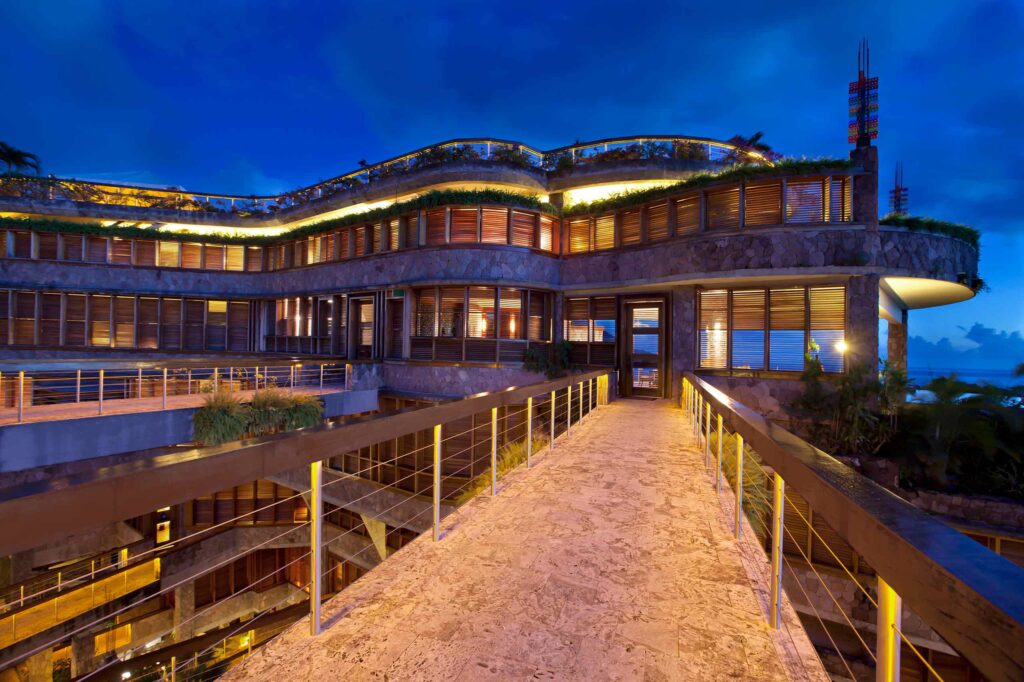
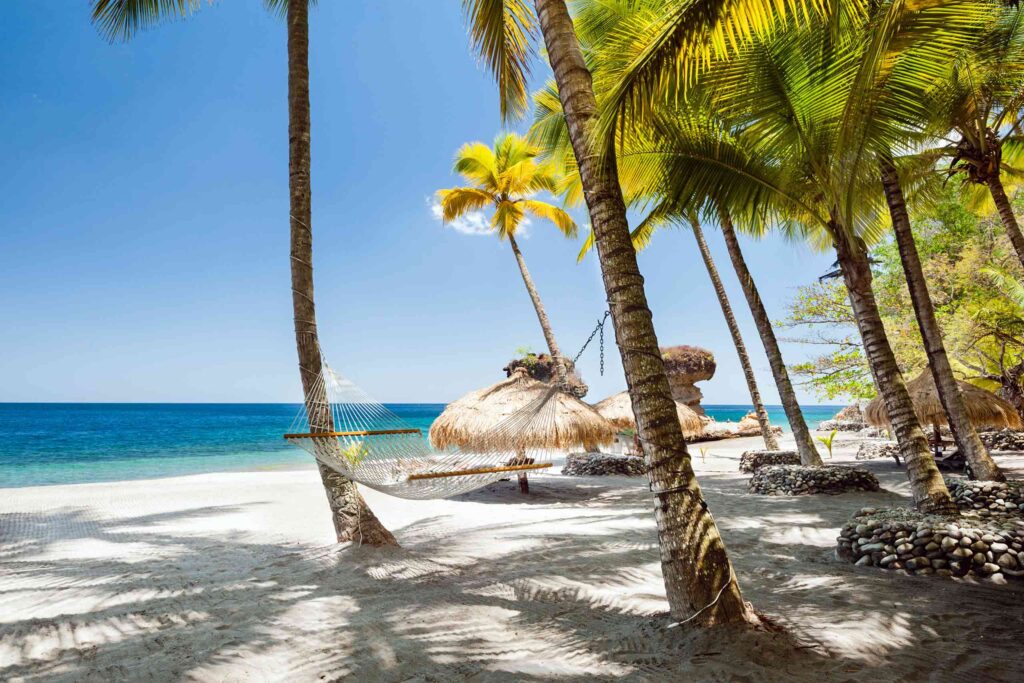
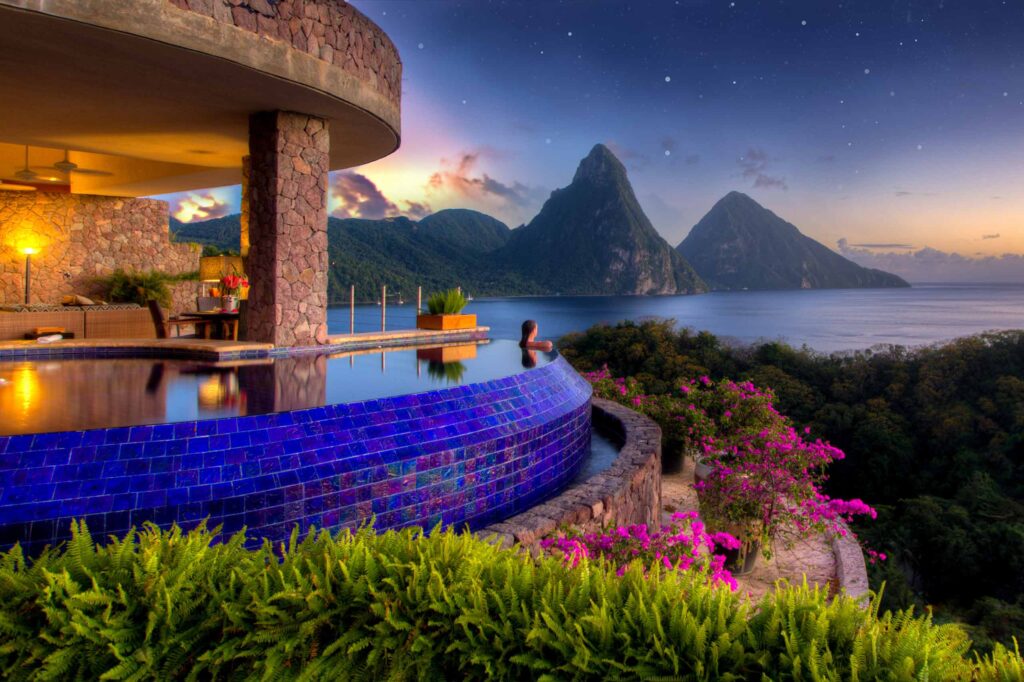
Karolin is a host in a way few hoteliers are these days, regaling us with anecdotes of celebrity visits and royal encounters. We can tell she has a finger in just about everything. A president here and an honorary consul there, Karolin also served as chair of the Caribbean Alliance of Sustainable Tourism and is the current chairperson of the Caribbean Biodiversity Fund. She’s arguably the driving force behind the hotel’s green ambition, which has made it the first in the Caribbean to receive gold certification in the LEED (Leadership in Energy and Environmental Design) building rating system. Jade Mountain’s environmentally sound construction aside, the resort also grows nearly half its produce on its very own organic Emerald Estate farm, and features a state-of-the-art water purification system paired with hydration stations.
Guests, meanwhile, are invited to take part in coral planting on the magnificent house reef. Community is another pillar of operations here. Saint Lucian craftsmen and artisans have been tasked to furnish both Jade Mountain as well as Anse Chastanet with handmade furniture, using local woods, from teak to red cedar and mahogany. The island’s beautiful national cloth – madras – also features prominently across the hotels, much to the delight of local seamstresses keen on safeguarding the traditional fabric for the future. One day during our stay, Karolin jokingly tells us “the furniture makers here are all 80 or 90 now and we never know whether they’ll live long enough to fulfil our next order.”
It’s difficult to imagine our top-floor Galaxy sanctuary – the most luxurious accommodation option at the resort and the very room Amy Winehouse honeymooned in – furnished any other way than it is. Across its 185 square metres of entirely open space, the sanctuary boasts a blend of rattan and blocky wooden furniture with chequerboard inlays, lampshades mounted on cross-sections of tree trunks, a four-poster bed with a heavy chest at its end, an elevated bathroom (all set with an enormous bathtub and freestanding shower) up a curved staircase, and a showstopping 85-square-metre circular, cantilevered infinity pool at its end. The specially commissioned tiles in it even have a textured surface that cleverly changes the colour of their shimmer depending on the angle you look at them from.
No two sanctuaries here are alike. Bathroom basins, for instance, are different in every room (“much to the dismay of our housekeeping staff, who have to clean so many different types,” says Karolin, dissolving into giggles). Its uncompromising idiosyncrasy – which even had Nick place a pool right down the middle of one of the sanctuaries, thereby dividing the space in two – is what makes Jade Mountain unique. While it’s not unusual to have a ‘first time for everything’ moment on travels, here, everything is a first time – the many different walkways and staircases leading up to the sky-bound resort from the grounds of the adjoining Anse Chastanet mean we take a different route up to our sanctuary each time we return from the beach.
Other aspects of our stay are no less stimulating, and often completely novel in the wider region. Anse Chastanet, whose restaurants welcome Jade Mountain guests, features Saint Lucia’s first vegan dining outlet, where curried banana soup, breadfruit ravioli with cashew-based ricotta, and mango teriyaki chargrilled tempeh send us on a pan-tropical voyage of island cuisines. A bean-to-bar experience at the resort’s chocolate laboratory is so thrilling we’re tempted to book the Chocolate Delight treatment at the property’s Kai en Ciel spa, but ultimately decide on a signature massage in the comfort of our sanctuary, with the Pitons in view.
Later, we dive into Saint Lucian culture at an art class with local muralist Naja Misaki Simeon, and take a walk through the ruins of the on-site 18th-century sugar plantation at Anse Mamin, during which our guide Tyson strikes an engaging balance between lighthearted entertainment and historical facts about the fate of the 60 slaves that once lived here. Amazingly, the walk immerses us in the island’s colonial past – uncommon in the Caribbean, where resorts rarely want guests to think about anything other than rum punches and beachside loungers.
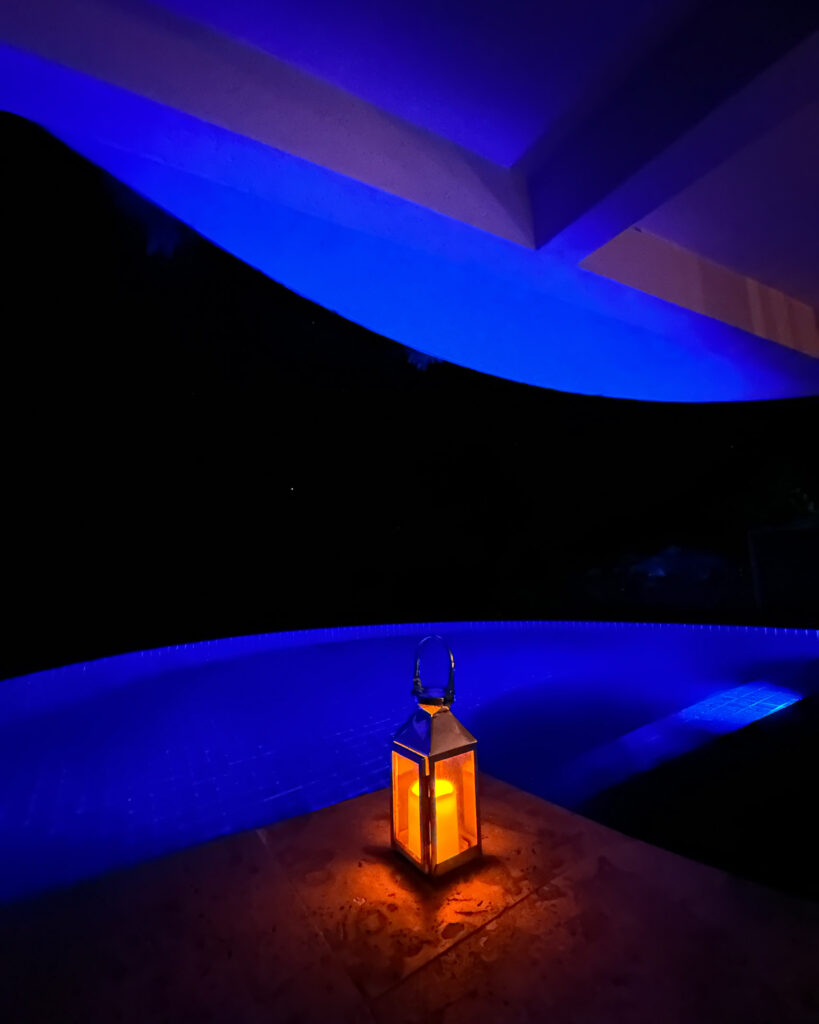
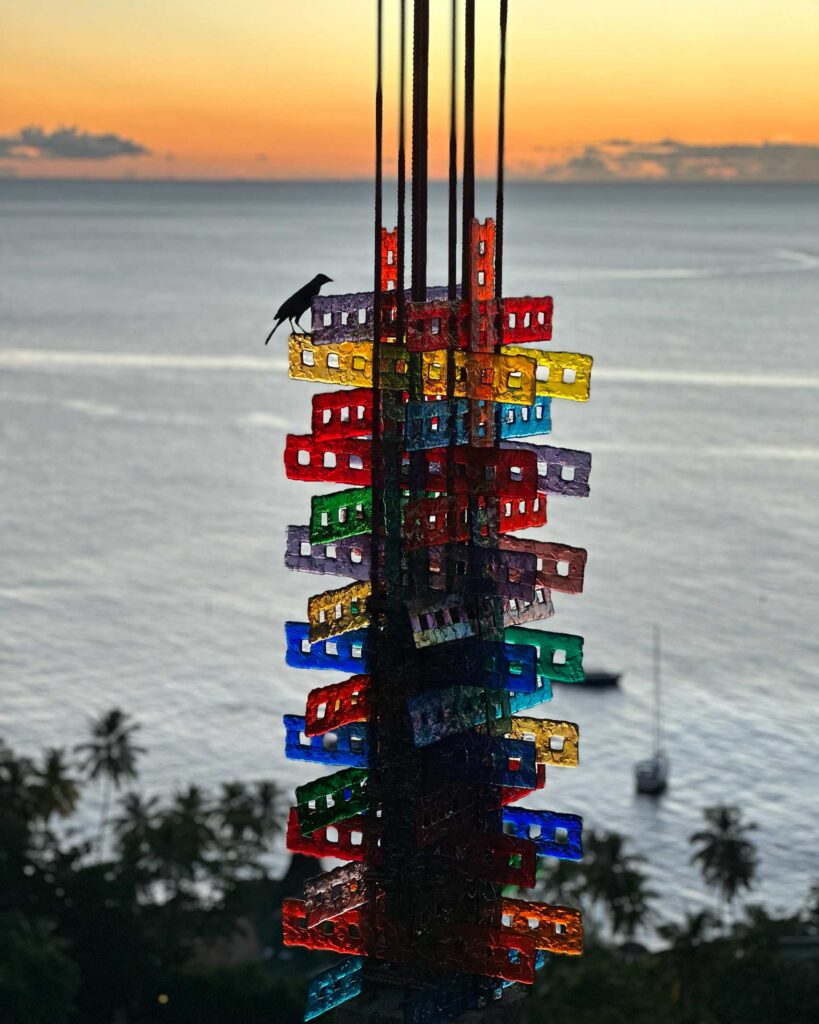
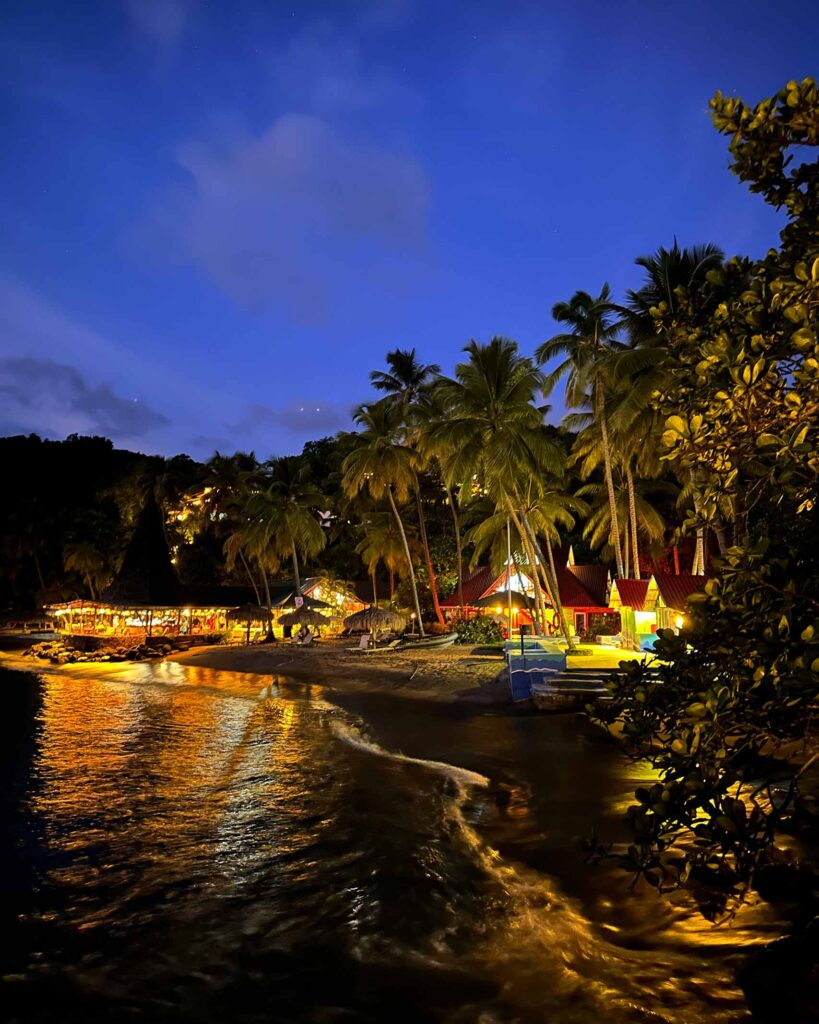
But Jade Mountain is evidently a hotel that thinks outside the box, and we soon sense that no one exemplifies this better than Karolin. Even extraterrestrial affairs are within the scope of a stay here, as Karolin demonstrates when she greets us at dinner on the resort’s Celestial Terrace under a clearly visible Milky Way.
“I love that our guests have this magical experience, but, you know, I once saw five shooting stars in a row and feared for the universe,” she laughs, as we wonder whether she secretly chairs some intergalactic association of cosmic affairs.
Back on Earth, it’s easy to see why someone would feel so connected to the natural phenomena all around them in a place like this. There are no TVs in Jade Mountain’s open-air sanctuaries, but the ever-present elements provide a sensorial backdrop of wonder and amazement. Trade winds waft right through our sanctuary at night, occasionally carrying a sulphurous smell from the nearby springs, or some animal sound of an unidentifiable nature. The sun and the moon flood the space with their iridescent light, and sometimes, as we brush our teeth, we spot small lizards dashing across the ceiling above our heads in the mirror.
One night, as we walk up to the edge of our pool, our gaze is drawn beyond it into the bay of Anse Chastanet, where hours before we had watched a single turtle hatch from its egg and scramble into the sea at sunset. It’s one of those great wonders of the natural world, to think that the tiny creature is now somewhere in the vast, black sea straight ahead, set to return – somewhat miraculously – to this very beach in some 10 or 20 years.
Many guests at Jade Mountain will no doubt follow suit, having found a quality in this place that has all but disappeared from most Caribbean resorts, which look out over the natural world, rather than placing you at its beating heart. Here, in our sanctuary open to the sun and the sea, to the warm salty breeze and the cheerful call of the Antillean crested hummingbird, there isn’t a heartbeat that escapes us.
Photography by Macduff Everton, Suzi Q, Steffen Michels and courtesy of Jade Mountain


